Introduction
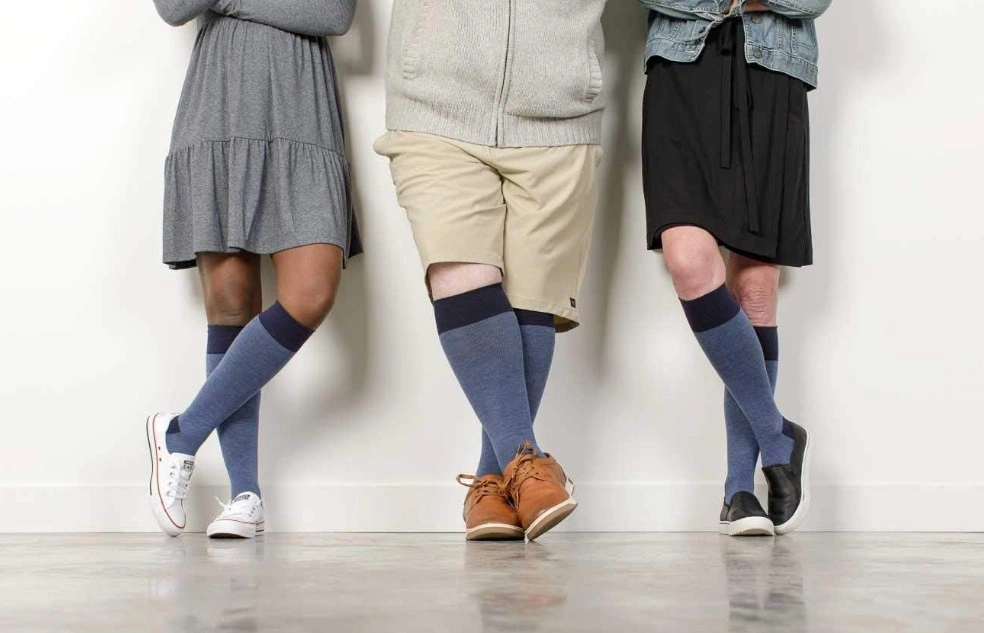
If you’ve ever had customers complain that their “compression socks don’t help at all” or that they’re “way too tight to wear,” you’ve already met the real problem: the wrong pressure level.
For wholesalers and retailers, the line between 15–20 mmHg and 20–30 mmHg is where customer satisfaction, repeat orders, and 1-star reviews are decided. These two levels look almost identical on a product sheet, but they solve very different needs. If you can’t clearly explain that difference, you’re leaving money — and trust — on the table.
Understanding how these products improve circulation and support athletic recovery will enhance your product range and increase customer satisfaction. The right choice can provide lasting benefits, whether your customers seek relief from swelling or enhanced performance.
So, 15-20 vs 20-30 mmHg Compression Socks: Which is Best? Choose 15-20 mmHg for everyday support, preventing tired legs, and for travel; it’s the ideal starting level. Opt for the firmer 20-30 mmHg compression to manage more significant issues like varicose veins, moderate edema (swelling), or for post-surgical recovery, typically under a doctor’s recommendation.
This guide breaks down the differences between these two compression levels, helping you make an informed decision for your business. By understanding the unique advantages of each option, you can ensure your product offerings meet diverse customer needs and stand out in a crowded marketplace.
What Does mmHg Mean in Compression Socks? Understanding Pressure Levels for Buyers

What Does mmHg Mean? A Guide to Compression Strength
The term “mmHg” stands for millimeters of mercury, a unit of measurement used to indicate the pressure exerted by compression socks on the legs. It’s an essential indicator of how much support the product provides. The higher the number, the more pressure the socks apply. For example, 15-20 mmHg provides a moderate level of support, perfect for those seeking everyday relief, while 20-30 mmHg offers firmer compression suited for medical or athletic needs.
The Role of mmHg in Defining Product Quality and Effectiveness
The right compression level directly impacts the effectiveness of the socks. A higher mmHg means greater support, but it’s crucial to understand that stronger pressure isn’t always better. Too much compression can disrupt circulation rather than improve it. A well-calibrated compression level ensures that the socks provide the right amount of support without causing discomfort or harm. Understanding mmHg allows you to offer products that not only meet customer expectations but also align with their health and wellness goals. It ensures that your product range meets varying needs, from light support for general use to stronger options for medical or performance purposes.
Compression Level Breakdown: Which Pressure Is Right for Your Customers?
8-15 mmHg (Light Compression)
Ideal for everyday fatigue, minor swelling, diabetes swelling, and prevention during pregnancy. You can explore the detailed info of our gentle 8-15 mmHg compression range for diabetics as an example. These socks help with light leg discomfort from sitting or standing for long periods and are effective for those looking to prevent the onset of varicose veins or improve circulation during pregnancy. Since these socks do not require a prescription, they are an excellent starting point for new users seeking mild relief or individuals with mild symptoms.
15-20 mmHg (Moderate Compression)
For customers experiencing moderate fatigue, mild varicose veins, swelling, or those in need of post-exercise recovery, 15-20 mmHg compression socks offer the perfect solution. This level provides enhanced support without being too intense, making it widely available without a prescription. It’s a popular choice in retail due to its versatility, helping customers with both preventative and recovery needs. Many people turn to these socks for everyday use, offering a balance of comfort and effectiveness.
20-30 mmHg (Medical Grade 1/Firm Compression)
20-30 mmHg compression socks are recommended for individuals dealing with moderate varicose veins, chronic leg pain, or those recovering from surgery. This pressure level is designed for more serious conditions, offering stronger support to improve circulation and reduce discomfort. A medical evaluation is often required before purchase, and in some cases, a prescription may be necessary. These socks are a top choice for customers looking for more intensive support and relief from persistent leg conditions.
30-40 mmHg (Medical Grade 2/Extra Firm Compression)
For those suffering from severe conditions such as Deep Vein Thrombosis (DVT), lymphedema, or significant swelling, 30-40 mmHg compression socks are a more specialized option. This pressure provides a much stronger level of support, addressing the most intense circulation issues. These socks are prescription-only and must be professionally fitted to ensure proper usage. They are essential for individuals with severe leg conditions who need maximum support and medical-grade effectiveness.
40-50 mmHg (Medical Grade 3/RX Compression)
The 40-50 mmHg compression level is the most intense and is used for severe venous insufficiency, chronic conditions, and other serious medical concerns. These socks offer extreme compression, targeting the most critical leg issues, and are reserved for professional medical use. They require strict adherence to medical advice and supervision. Typically, only those with specific medical needs or conditions will benefit from this level of compression, making it a highly specialized option for the most severe cases.
Why 15-20 mmHg Compression Socks Are Ideal for Daily Wear and General Support
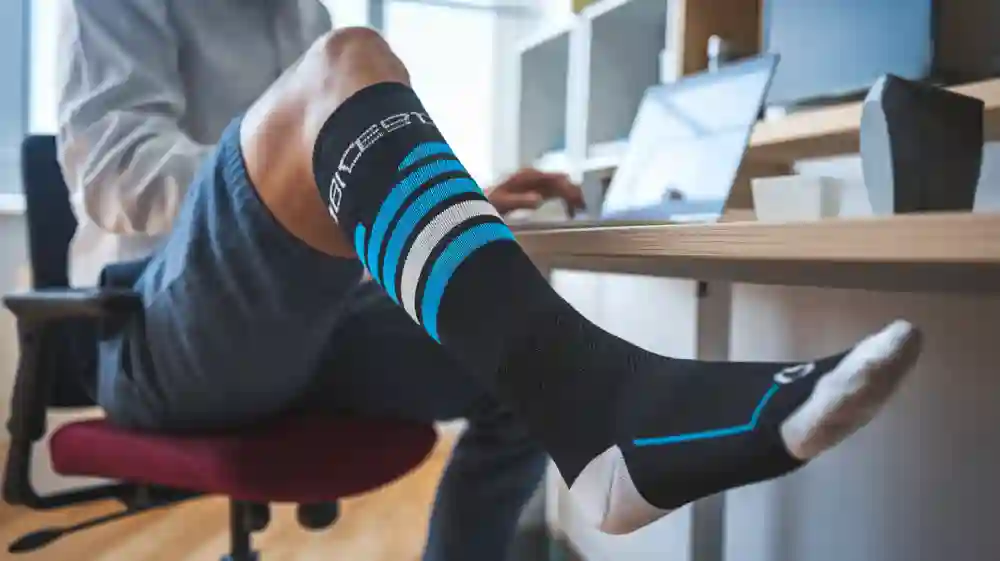
Advantages of 15-20 mmHg Compression Socks and General Use
Compression socks with a 15-20 mmHg rating offer a moderate level of pressure that is ideal for those seeking general relief without the intensity of higher-level options. These socks are perfect for everyday use, offering mild support to improve circulation and reduce discomfort from long periods of standing, sitting, or walking. Whether it’s for people who experience occasional leg fatigue or those who want a preventive solution, these socks provide the right balance of comfort and functionality.
Market Demand: Why 15-20 mmHg Compression Socks Are a Safe Bet for Retailers
The demand for 15-20 mmHg socks is steadily increasing, especially among consumers looking for relief from common leg issues such as fatigue, swelling, or minor varicose veins. This compression level is versatile, appealing to a wide customer base, including office workers, travelers, athletes, and pregnant women. Its popularity in retail makes it a safe bet for suppliers, as it caters to both general health-conscious individuals and those seeking support during long days or travel. This makes it an easy-to-sell product with broad appeal across various demographics.
Key Benefits for Customers: Comfort, Circulation, and Recovery
For customers, the 15-20 mmHg compression socks offer multiple benefits. They help enhance blood flow, reducing swelling and discomfort in the legs, which can be especially useful for individuals who spend long hours on their feet. These socks also aid in faster recovery after physical activity by minimizing muscle soreness and reducing lactic acid build-up. The moderate compression promotes a sense of comfort and well-being, making these socks a daily go-to solution for those seeking simple, effective relief.
Targeted Relief and Recovery: The Role of 20-30 mmHg Compression Socks
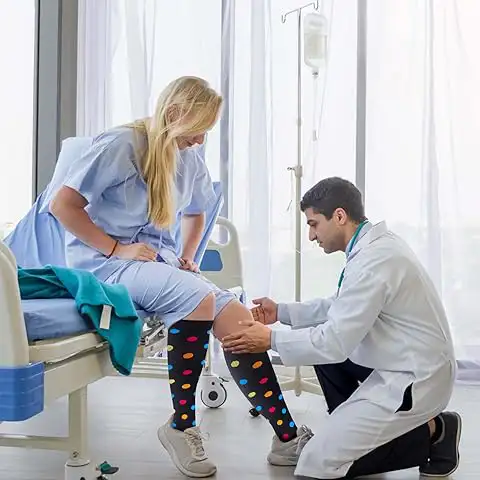
Benefits of 20-30 mmHg Compression Socks
Compression socks rated at 20-30 mmHg offer a higher level of pressure, providing targeted support for those dealing with more serious health concerns. This pressure level is specifically designed to address conditions like moderate varicose veins, chronic leg pain, and post-surgery recovery. It also provides significant relief for individuals experiencing moderate swelling or those recovering from injuries. The 20-30 mmHg range helps to promote optimal circulation, reduce venous pressure, and prevent blood pooling, making it an ideal option for individuals needing focused support.
Growing Demand in the Medical and Sportswear Markets
The demand for 20-30 mmHg compression socks is growing rapidly in both the medical and sports industries. In the medical field, these socks are commonly recommended by healthcare providers for patients with moderate venous insufficiency or those recovering from surgery. In the sports world, athletes are increasingly turning to these socks to enhance performance and recovery. This surge in demand makes them an attractive option for wholesale suppliers looking to expand their product offerings into specialized markets, providing a premium option for customers seeking advanced compression solutions.
Customer Benefits: Pain Relief, Swelling Reduction, and Enhanced Performance
The 20-30 mmHg compression socks provide significant relief for individuals suffering from moderate pain and swelling in the legs. By improving circulation, these socks help reduce discomfort from conditions such as varicose veins, arthritis, and muscle fatigue. Athletes also benefit from enhanced performance and faster recovery after intense workouts or competitions. The increased pressure promotes better oxygen flow to the muscles, reducing muscle soreness and fatigue, while also accelerating the elimination of metabolic waste products like lactic acid. For customers who need more intense support, these socks deliver on both comfort and medical-grade effectiveness.
Key Differences Between 15-20 mmHg and 20-30 mmHg Compression Socks
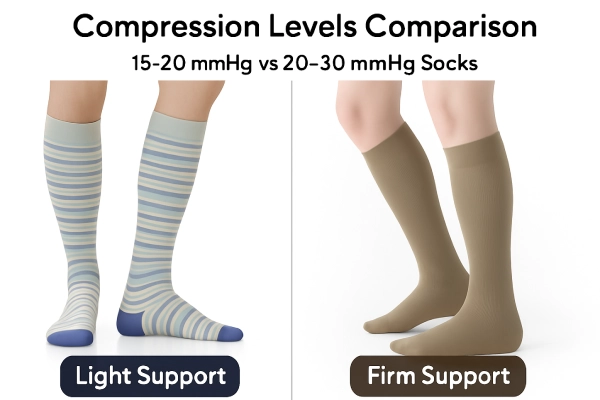
15–20 mmHg compression socks focus more on comfort and everyday wear, while 20–30 mmHg socks prioritize performance and targeted medical support.
The differences between 15–20 mmHg and 20–30 mmHg compression socks lie in two main aspects:
Knit structure and yarn composition
Higher compression levels aren’t simply “tighter” versions of moderate ones — they use completely different yarn systems.
Scientific studies show that moderate compression (15–20 mmHg) typically uses finer elastane yarns for both the looped structure and the inlaid yarn. In contrast, higher compression (20–30 mmHg) socks adopt a more robust setup with thicker, more powerful inlaid yarns to generate greater squeeze. For example, a 15–20 mmHg sock may use a 52 dtex elastane yarn (double-covered) for the base knit and a 232 dtex yarn as the inlay. But in 20–30 mmHg designs, the base can jump to 120 dtex, with an inlay yarn as heavy as 700 dtex — delivering significantly more restraining force. This engineered design, rather than just tightness, is what creates stronger graduated compression.
Gradient pressure distribution
Because compression socks apply graduated pressure, the pressure decreases from the ankle upward.
However, the rate of pressure change (gradient) also differs between compression levels.
In 15–20 mmHg socks, the gradient is gentler — offering mild support and better comfort for general use.
In 20–30 mmHg socks, the pressure drop from ankle to calf is much steeper, targeting stronger venous return.
This difference means high-compression socks not only squeeze harder but also manage how that pressure is distributed, which is critical for medical or post-surgical uses.
How to Help Your Customers Choose the Right Compression Sock Level
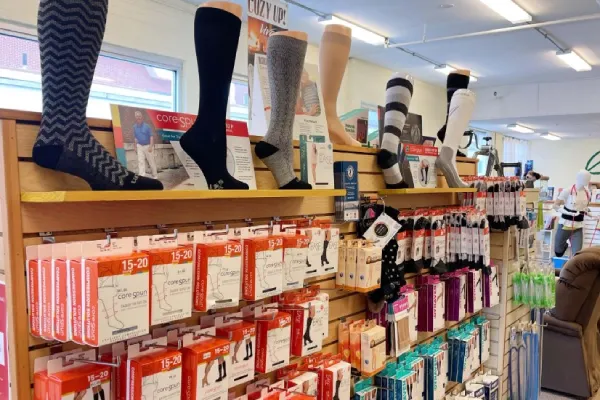
Understanding Your Market: Wholesale Buyers’ Preferences and Demands
Understanding your customer base is crucial for wholesale success. Learn how to match products to specific user needs by reading 5 essential tips for selecting the most profitable compression levels for your retail line. Wholesale buyers are typically looking for products that appeal to a broad audience while addressing specific pain points. Buyers may prioritize comfort, ease of use, and effectiveness based on the demographics of their customers. For instance, retailers targeting health-conscious individuals might prefer lighter compression socks for general use, while those catering to medical professionals or athletes may lean towards higher compression options. By knowing the unique demands of different customer segments, you can curate a selection that meets both consumer expectations and business goals.
Factors to Consider: Activity Level, Medical Conditions, and Comfort Needs
To choose the right compression socks for your customers, consider factors like activity level and comfort needs. For those with specific health concerns, check our analysis on Compression Socks vs. Medical Stockings to learn which product type best serves your target medical market. For customers who are relatively inactive or have mild swelling, a lower pressure level, like 15-20 mmHg, is usually sufficient. On the other hand, those who are highly active, recovering from injury, or experiencing chronic pain may benefit from socks with higher pressure, such as 20-30 mmHg. Additionally, understanding any specific health conditions, such as varicose veins or post-surgery recovery, is vital when determining the most suitable compression level. Comfort is also key – socks that are too tight can cause discomfort, while those too loose may not provide sufficient support. Balancing these factors ensures that your product offering meets customer needs effectively.
Customization Options: Tailoring Products to Meet Specific Customer Requirements
Customization is a powerful tool in the wholesale market, allowing you to offer personalized solutions to meet your customers’ unique needs. Compression socks can be tailored in various ways, including adjustments in material, color, size, and design, to appeal to different demographics. Learn how to select the ideal materials for compression socks, from breathable cotton to advanced moisture-wicking blends, to enhance your brand’s market appeal. For example, catering to diverse comfort preferences starts with the right fabric choice. Additionally, providing options for custom logos or packaging can help your clients create a unique product for their own brand, strengthening customer loyalty. By offering customization, you not only meet the specific needs of customers but also create a product line that stands out in a competitive marketplace. Explore our custom compression socks to create tailored solutions that meet your clients’ unique requirements.
Choosing the Right Material and Style for Your Compression Socks
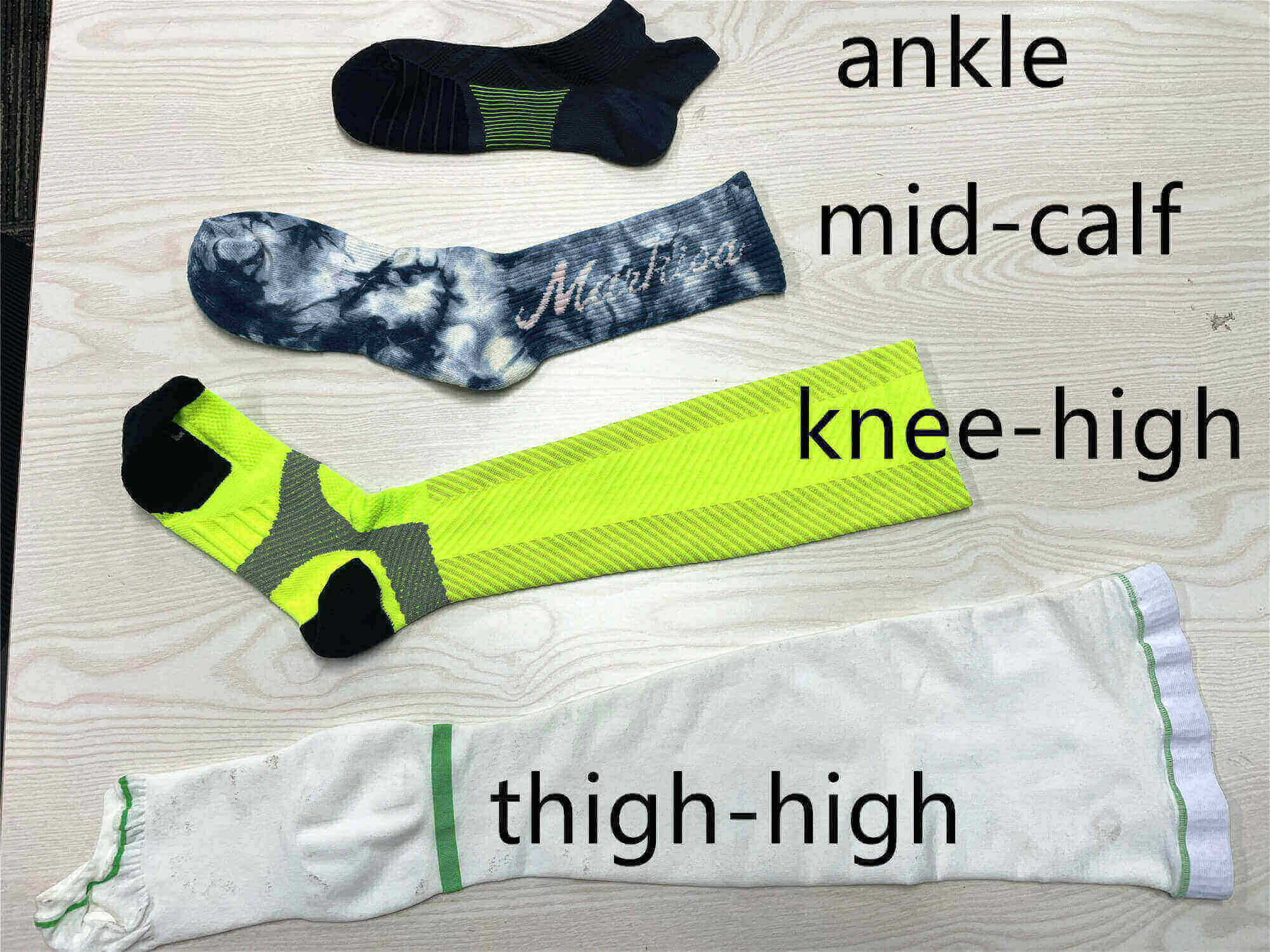
Style Choices: Knee-High, Thigh-High, or Full-Length Tights
Compression socks come in a variety of styles, as shown in the image above, each suited for different needs and preferences.
Knee-high socks are the most common style, offering a balance between ease of wear and effectiveness. For brands looking for a discreet aesthetic, our custom knee-high no-show compression socks are ideal for everyday use or travel, providing professional support without the bulky look of traditional socks.
Thigh-high socks provide extra coverage and are often preferred by individuals with more extensive swelling. As a specialized manufacturer, we offer custom thigh-high anti-embolism compression stockings designed for maximum efficacy in treating severe varicose veins and post-surgical recovery.
Full-length tights, which offer full leg compression, are suitable for those seeking maximum support, especially after surgery or for athletes in need of comprehensive recovery. The choice of style will depend on your customers’ specific needs, and offering a range of options ensures you can meet diverse requirements.
Why Material and Style Matter in Customer Satisfaction
The right combination of material and style can greatly enhance customer satisfaction. Comfort is a primary concern for compression sock users, and selecting the right fabric ensures that customers will be more likely to wear the product consistently. The style, too, can impact comfort and effectiveness. For example, those who need compression for only their lower legs may prefer knee-high socks, while individuals needing more comprehensive support may opt for thigh-high or full-length options. Understanding your customers’ preferences for both material and style will help you offer products that cater to a broad market, ensuring high-quality results and repeat business.
Conclusion
When deciding between 15-20 mmHg and 20-30 mmHg compression socks for your business, it’s essential to understand the distinct needs of your customer base. The 15-20 mmHg socks offer moderate support, making them ideal for everyday wear, light fatigue, and general recovery, appealing to a broad audience. On the other hand, the 20-30 mmHg socks provide a higher level of compression for those with more specific medical needs, such as moderate varicose veins or post-surgery recovery. Offering both options ensures that you can meet the demands of customers seeking both general comfort and targeted relief, making your product line versatile and appealing to a wide range of consumers.

Consumer preferences are driven by comfort, effectiveness, and specific health needs. As the demand for compression socks continues to grow, businesses should position their products based on the pressure levels and styles that best serve their target markets. Whether catering to individuals looking for everyday comfort or those requiring more specialized support, offering a range of compression options allows businesses to meet diverse needs and maintain customer satisfaction. By understanding the unique benefits of each compression level, enterprises can make informed decisions about which products to offer, ensuring that their portfolio resonates with customers and stands out in the competitive market.
FAQ
What’s the difference between 15-20 mmHg and 20-30 mmHg compression?
The numbers (mmHg) indicate the pressure level. 15-20 mmHg offers moderate compression, ideal for all-day energy, travel, and mild swelling. 20-30 mmHg provides firm compression for more significant issues like moderate edema, post-surgery recovery, or as directed by a doctor for managing medical conditions.
Which compression level is best for daily wear or long periods of sitting?
For general daily wear, such as running and preventing fatigue, 15-20 mmHg is excellent. However, studies show that 20-30 mmHg can be more effective at reducing leg swelling and discomfort for those who sit or stand for prolonged periods, making it a powerful choice for long workdays.
What is the best compression level for flying?
A moderate compression level of 15-20 mmHg is generally sufficient and highly effective for most travelers. This level helps improve circulation and reduce the risk of swelling and blood clots during flights without feeling uncomfortably tight, ensuring you arrive at your destination with refreshed legs.
How do I know which size and compression level is right for me?
First, choose a compression level based on your needs (15-20 mmHg for wellness, 20-30 mmHg for more support). Then, measure your ankle and calf to find your size on the product’s chart. If you’re between sizes, it’s usually best to size up for a comfortable, snug fit.
How long should I wear my compression socks each day?
For best results, put them on in the morning and wear them throughout your day, especially during periods of activity or long hours of sitting/standing. It is generally advised to remove them before bed unless you have been specifically instructed by a doctor to wear them overnight.
